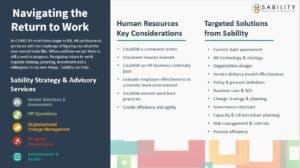Many human capital thought leaders are providing ad vice on how to return to work and offering services to support businesses as they transition. Faced with a saturation of ‘return to work’ guidance, professionals in the HR function are forced to stop and reflect on the pain endured, challenges overcome, and the path forward to some sense of normalcy.
vice on how to return to work and offering services to support businesses as they transition. Faced with a saturation of ‘return to work’ guidance, professionals in the HR function are forced to stop and reflect on the pain endured, challenges overcome, and the path forward to some sense of normalcy.
Now, as restrictions begin to lift, we are faced with the challenge of figuring out what our new work environment looks like. When and how we get there is still a work in progress. Our approach must allow us to quickly pivot should this virus, or another, resurface again.
Why is everyone offering a perspective on how to return business to normal? Because it requires strategy, planning, investment and a willingness to try new things. The pressure to get this right is immense because our workforce and our customers have high expectations. Getting this right takes time and resources.
As you navigate establishing an approach, here are a few key considerations to keep in mind:
- Establish a command center by organizing the right decision makers and support resources to quickly mobilize, make decisions and disseminate critical information.
- Document lessons learned while they are fresh in your mind. What worked, what did not, and how can your organization rapidly implement an improved business resiliency plan?
- Establish a method to synthesize federal, state and local government regulations and understand their impact on your return to work approach.
- Assess what positions do not require a physical presence and develop a method of measuring success in this model. Although not for everyone, you will have employees who thrive remotely, and the business does not require their physical presence daily. Identifying this group of performers will be valuable in your short- and long-term planning strategies.
Your organization has and will continue to assess the damage caused by COVID-19. Many of us will be challenged to do more with less while serving our employees and maintaining business continuity. While business returns to normal, HR will need to carefully examine the efficiency in how it acquires, moves, exits and communicates with the workforce. Invest in improvements that make the business more agile, allowing it to react quickly and mitigate future organizational harm.

Director of Strategy & Advisory Services
Steven Kurtz is a human capital consulting leader focused on leveraging efficient process, industry leading technology and data insights to position the HR function as strategic in nature, drive efficiency in service delivery and maximize the customer experience. Steven is responsible for Sability’s Strategy & Advisory practice across all Sability clients. Prior to Sability, Steven was a Senior Manager in the EY People Advisory Services practice; leading the delivery of consulting projects at large domestic and international clients. Prior to consulting, Steven also held roles in HR service delivery and talent acquisition functions. Steven holds PMP, PHR, Six Sigma Yellow Belt and Professional Scrum Master credentials and received his Bachelor of Arts degree in Political Science from Lebanon Valley College.
